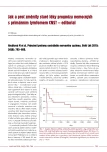Therapy with implantable cardioverter‑defibrillators (ICD) in the early of third millenium
Authors:
M. Kozák
Authors‘ workplace:
Interní kardiologická klinika Lékařské fakulty MU a FN Brno, pracoviště Bohunice, přednosta prof. MUDr. Jindřich Špinar, CSc., FESC
Published in:
Vnitř Lék 2010; 56(8): 860-864
Category:
50th Birthday - Jindřich Špinar, MD, CSc., FESC
Overview
The patients without ventricular arrhythmias with markers of high risk of sudden cardiac death are indicated for ICD implantation today. Last generation of ICD systems are equipped with high capacity batteries, with many automatic functions, capabilities of data sending and possibilities of prediction of worsening of heart failure. Nowadays ICD systems offers not only elimination of the risk of sudden cardiac death but reduction of symptoms of chronic heart failure through the resynchronization therapy, too.
Key words:
ICD (implantable cardioverter‑defibrillator) – indication – technology
Sources
1. Mirowski M, Reid PR, Mower MM et al. Termination of malignant ventricular arrhythmias with an implanted automatic defibrillator in human beings. N Engl J Med 1980; 303: 322–324.
2. Connolly SJ, Gent M, Roberts RS et al. Canadian implantable defibrillator study (CIDS): a randomized trial of the implantable cardioverter defibrillator against amiodarone. Circulation 2000; 101: 1297–1302.
3. Buxton AE, Lee KL, Fisher JD et al. A randomized study of prevention of sudden death in patients with coronary artery disease: Multicenter Unsustained Tachycardia Trial Investigators. N Engl J Med 1999; 341: 1882–1890.
4. Moss AJ, Zareba W, Hall WJ et al. Prophylactic implantation of a defibrillator in patients with myocardial infarction and reduced ejection fraction. N Engl J Med 2002; 346: 877–883.
5. Boriani G, Biffi M, Martignani C et al. Cardioverter‑defibrillators after MADIT II: the balance between weight of evidence and treatment costs. Eur J Heart Fail 2003; 5: 419–425.
6. Bardy GH, Lee KL, Mark DB et al. Amiodarone or an implantable cardioverter‑defibrillator for congestive heart failure. N Engl J Med 2005; 352: 225–237.
7. Bristow MR, Saxon LA, Boehmer J et al. Cardiac‑resynchronization therapy with or without an implantable defibrillator in advanced chronic heart failure. N Engl J Med 2004; 350: 2140–2150.
8. Wilkoff BL, Cook JR, Epstein AE et al. Dual‑chamber pacing or ventricular back-up pacing in patients with an implantable defibrillator: the Dual Chamber and VVI Implantable Defibrillator (DAVID) trial. JAMA 2002; 288: 3115–3123.
9. Sharma AD, Rizo‑Patron C, Hallstrom AP et al. DAVID Investigators. Percent right ventricular pacing predicts outcomes in the DAVID trial. Heart Rhythm 2005; 2: 830–834.
10. Lamas GA, Lee KL, Sweeney MO et al. Mode selection trial in sinus‑node dysfunction. Ventricular pacing or dual‑chamber pacing for sinus‑node dysfunction. N Engl J Med 2002; 346: 1854–1862.
11. Wathen MS, DeGroot PJ, Sweeney MO et al. Prospective randomized multicenter trial of empirical antitachycardia pacing versus shocks for spontaneous rapid ventricular tachycardia in patients with implantable cardioverter‑defibrillators: Pacing Fast Ventricular Tachycardia Reduces Shock Therapies (PainFREE Rx II) trial results. Circulation 2004; 110: 2591–2596.
Labels
Diabetology Endocrinology Internal medicineArticle was published in
Internal Medicine

2010 Issue 8
Most read in this issue
- Care for patients on mechanical ventilation from the perspective of an internal medicine physician
- Therapy with implantable cardioverter‑defibrillators (ICD) in the early of third millenium
- Anaemia in chronic heart failure
- Changes in NT‑proBNP levels in patients with atrial fibrillation related to heart failure
